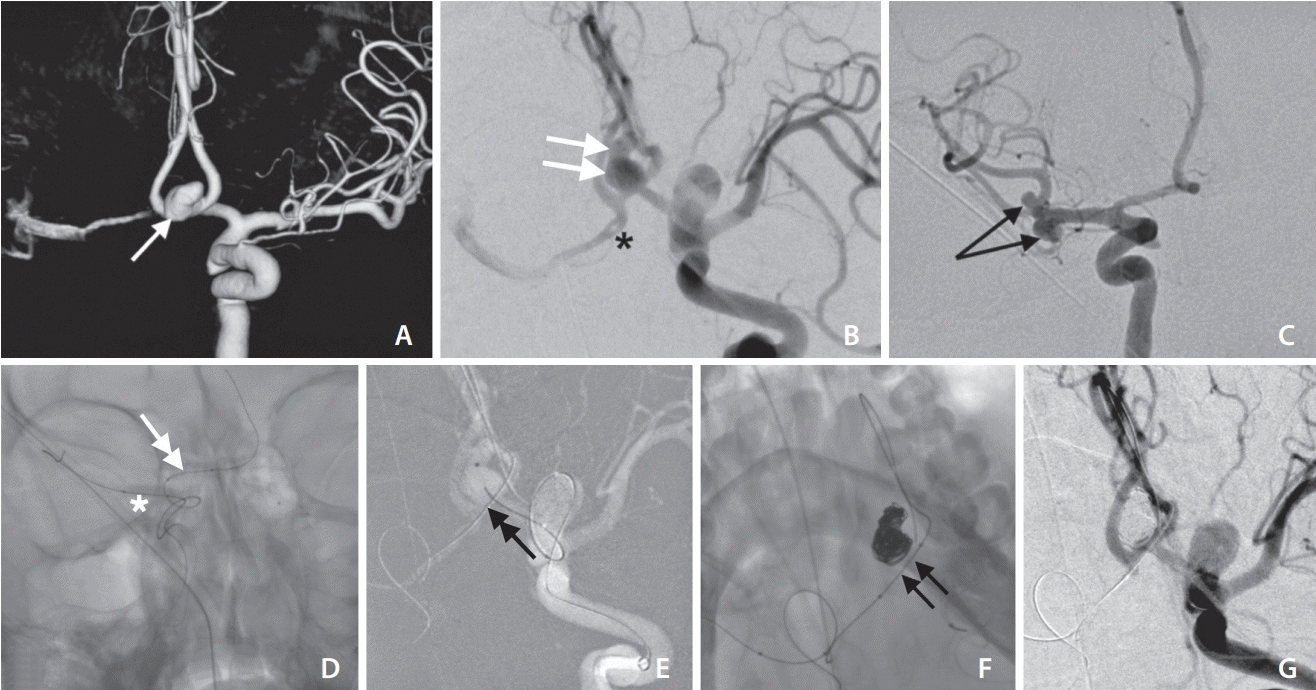1. Moret J, Cognard C, Weill A, Castaings L, Rey A. The “remodelling technique” in the treatment of wide neck intracranial aneurysms. Angiographic results and clinical follow-up in 56 cases. Interv Neuroradiol. 1997; 3:21–35.
2. Alaraj A, Wallace A, Dashti R, Patel P, Aletich V. Balloons in endovascular neurosurgery: history and current applications. Neurosurgery. 2014; 74 Suppl 1:S163–S190.
3. Shi ZS, Loh Y, Duckwiler GR, Jahan R, Viñuela F. Balloon-assisted transarterial embolization of intracranial dural arteriovenous fistulas. J Neurosurg. 2009; 110:921–928.

4. Rajah G, Narayanan S, Rangel-Castilla L. Update on flow diverters for the endovascular management of cerebral aneurysms. Neurosurg Focus. 2017; 42:E2.

5. Zhao WY, Krings T, Yang PF, Liu JM, Xu Y, Li Q, et al. Balloon-assisted superselective microcatheterization for transarterial treatment of cranial dural arteriovenous fistulas: technique and results. Neurosurgery. 2012; 71(2 Suppl Operative):ons269–273.
6. Mendes GA, Silveira EP, Saleme S, Iosif C, Ponomarjova S, Caire F, et al. Balloon-assisted microcatheter navigation for AVM embolization: technical note. J Neurosurg. 2015; 123:1120–1124.

7. Mahajan A, Goel G. Endovascular treatment of distal lenticulostriate artery aneurysm by selective catheterization of artery with balloon-blocking technique: 2-dimensional video illustration. World Neurosurg. 2020; 136:220.

8. Meyers PM, Schumacher HC, Higashida RT, Derdeyn CP, Nesbit GM, Sacks D, et al. Reporting standards for endovascular repair of saccular intracranial cerebral aneurysms. Stroke. 2009; 40:e366–e379.

9. Pierot L, Cognard C, Spelle L, Moret J. Safety and efficacy of balloon remodeling technique during endovascular treatment of intracranial aneurysms: critical review of the literature. AJNR Am J Neuroradiol. 2012; 33:12–15.

10. Albuquerque FC, Gonzalez LF, Hu YC, Newman CB, McDougall CG. Transcirculation endovascular treatment of complex cerebral aneurysms: technical considerations and preliminary results. Neurosurgery. 2011; 68:820–829.

11. Moret J, Ross IB, Weill A, Piotin M. The retrograde approach: a consideration for the endovascular treatment of aneurysms. AJNR Am J Neuroradiol. 2000; 21:262–268.
12. Heye S, Stracke CP, Nordmeyer H, Heddier M, Stauder M, Chapot R. Retrograde access to the posterior inferior cerebellar artery in balloon-assisted coiling of posterior inferior cerebellar artery aneurysms. J Neurointerv Surg. 2015; 7:824–828.

13. Cekirge SH, Yavuz K, Geyik S, Saatci I. HyperForm balloon-assisted endovascular neck bypass technique to perform balloon or stent-assisted treatment of cerebral aneurysms. AJNR Am J Neuroradiol. 2007; 28:1388–1390.

14. Chapot R, Nordmeyer H, Heddier M, Velasco A, Schooss P, Stauder M, et al. The sheeping technique or how to avoid exchange maneuvers. Neuroradiology. 2013; 55:989–992.

15. Wolfe SQ, Farhat H, Moftakhar R, Elhammady MS, Aziz-Sultan MA. Intraaneurysmal balloon assistance for navigation across a wide-necked aneurysm. J Neurosurg. 2010; 112:1222–1226.

16. Ito H, Onodera H, Wakui D, Uchida M, Sase T, Morishima H, et al. The “temporary caging” technique for catheter navigation in patients with intracranial wide-necked aneurysms. Int J Clin Exp Med. 2015; 8:11214–11219.
17. Bechan RS, Sprengers ME, Majoie CB, Peluso JP, Sluzewski M, van Rooij WJ. Stent-assisted coil embolization of intracranial aneurysms: complications in acutely ruptured versus unruptured aneurysms. AJNR Am J Neuroradiol. 2016; 37:502–507.

18. Dey M, Awad IA. Fenestration of supraclinoid internal carotid artery and associated aneurysm: embryogenesis, recognition, and management. World Neurosurg. 2011; 76:592.e1–592.e5.

19. Guo X, Gao L, Shi Z, Liu D, Wang Y, Sun Z, et al. Intracranial arterial fenestration and risk of aneurysm: a systematic review and meta-analysis. World Neurosurg. 2018; 115:e592–e598.

20. Morrison J, Alexander MD, Dowd CF, Cooke DL. Flanking the fenestration: circumferential limb-to-limb stent-assisted coiling of a basilar artery fenestration aneurysm. J Neurointerv Surg. 2018; 10:e12.







 PDF
PDF Citation
Citation Print
Print



 XML Download
XML Download